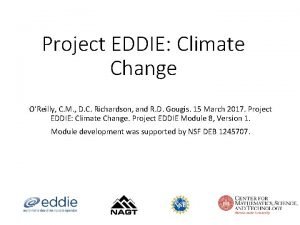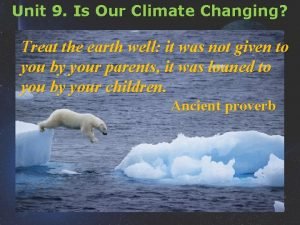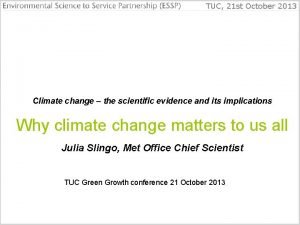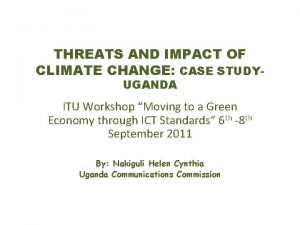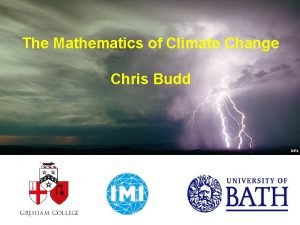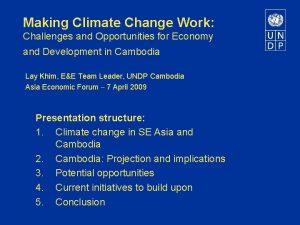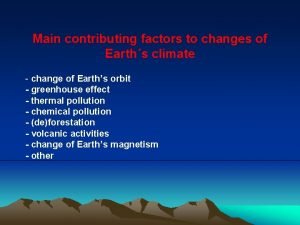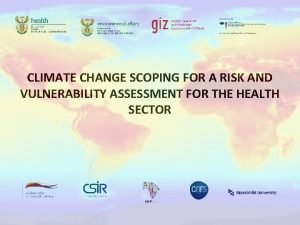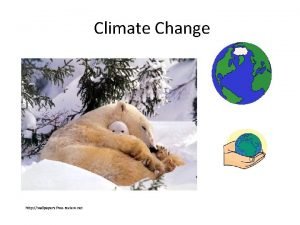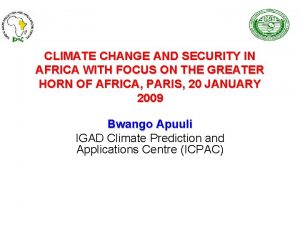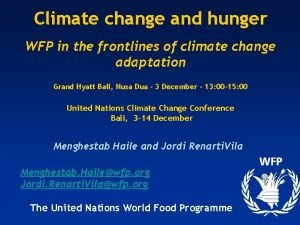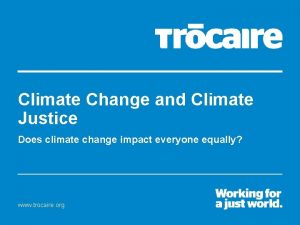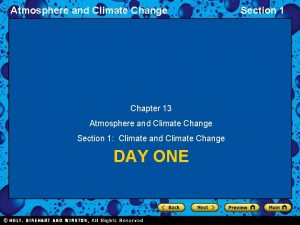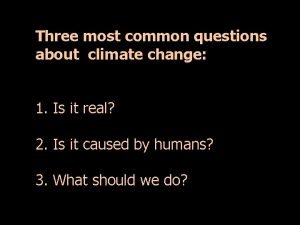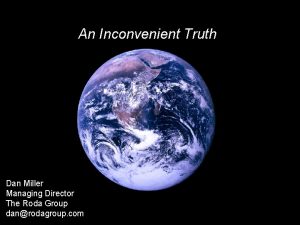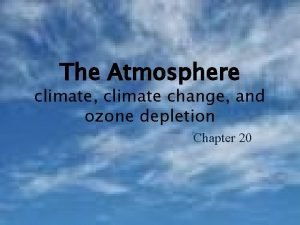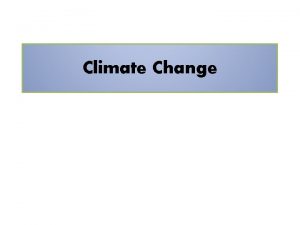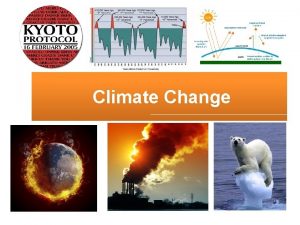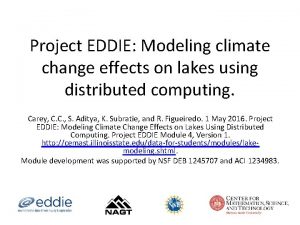Project EDDIE Climate Change OReilly C M D


































- Slides: 34

Project EDDIE: Climate Change O’Reilly, C. M. , D. C. Richardson, and R. D. Gougis. 15 March 2017. Project EDDIE: Climate Change. Project EDDIE Module 8, Version 1. Module development was supported by NSF DEB 1245707.

What controls the Earth’s temperature? • Amount of energy received by the sun • Reflection vs absorption of sun’s energy (albedo) • The amount of energy retained by the earth’s atmosphere.

Solar irradiance: position relative to the sun (Milankovitch cycles) The path of the earth around the sun and the angle of the earth vary at different time scales. Has been important influence for glacial periods (every 100, 000 years) over the past 500, 000 years.

Solar irradiance: Sunspot cycles • Sunspots – reflect magnetic activity of sun, and sun’s brightness. • Approximately an 11 year cycle (913) • Maunder minimum coincides with the Little Ice Age.

Reflection of energy Albedo (reflectivity) • Lighter things reflect more light energy • Darker things absorb more light energy (heat) • (Creates positive feedback) Aerosols lead to increased reflection of solar radiation. Volcanic activity → cooling.

Atmospheric composition • Gasses in the atmosphere influence temperature • Diagram the greenhouse effect

How global warming works The greenhouse effect: Energy is retained. • Gases in the atmosphere trap heat. • • CO 2 CH 4 NOxs CFCs

How do we know this global temperature? • Hansen et al. 2010 from Goddard Institute for Space Studies, NASA • http: //pubs. giss. nasa. gov/docs/2010_Hansen _etal_1. pdf • Compiled different datasets from weather stations all over the world. • Used a model to interpolate (smooth) data for land • Use bucket (ships) and satellite measurements calibrated with ship measurements for the ocean

Question 1: Is this global temperature changing over time? Is earth ‘warming’? If so, at what rate? How do we determine if something is changing? The easiest way is to look at average trend over time. We apply a mathematical relationship to look at trends over time.

Linear regression overview y = m*x + b m b

Linear regression overview r 2=proportion of variation explained R 2~0 0% of variability explained

Linear regression overview r 2=proportion of variation explained R 2~1 100% of variability explained, perfect line

Linear regression overview r 2=proportion of variation explained R 2>0. 3 30% of variability explained, Possible predictor but other drivers are playing a role

Question 1: Is this global temperature changing over time? Is earth ‘warming’? If so, at what rate? Activity A: graph the global average temperature found in your dataset and create a linear model to determine the rate of change. Be careful with units for rate!

Question 2: What might be causing this change in global average temperature? • What are the options?

Greenhouse gases play a role!

Mauna Loa CO 2 dataset Dr. Dave Keeling started measuring the CO 2 concentration in air in 1958 Collected air in vacuum cleared glass flasks and measured CO 2 content (masking tape holds the glass in case of implosion) Still measured with the method today (as well as sensors) Original flask at Science Museum in London

Question 2: What might be causing this change in global average temperature? Activity A: Graph the Mauna Loa CO 2 concentration dataset.

Question 3: How are temperature and CO 2 related? Activity B: Graph temperature and CO 2 concentrations over the same time period.

But this is only recent history… • The earth is 4. 54 billion years old • The last ice age was 110, 000 to 12, 000 years ago with peak glaciation 22, 000 years ago • The world looked different! • Northern USA and Canada covered by ice (grey) • Southern US covered by taiga (coniferous forest) and grassland • Southern Europe was tundra Ray and Adams 2001

Question 4: How can we compare the recent data to geologic history?

You’re off on a trip. . .

Vostok, Antarctica • Also go to Google Maps, see the single image there.

You’re off on a trip. . . • It should be worth it, since you’ll get to see Metallica play. . .

Steps in taking an ice core

Core processing

Air bubbles contain gas • Air bubbles trapped in the ice represent atmospheric chemistry.

Air temperature determined by water chemistry (oxygen isotope example) • The isotope ratios in the ice water reflect the climate’s temperature

Question 4: How can we compare the recent data to geologic history? Activity C: What is the maximum rate of change in the ice core record? • How do the data compare to current conditions in Antarctica? • Find the fastest rate of change in the ice core data – graph the data first and then pull out a time with the fastest change: • Vostok air temperature • Vostok atmospheric CO 2 • How do the pre-historic rates of change compare to current rates of change?

• Temperature are higher than they have been in the last 500, 000 years. How do we know that recent changes are due to human activity? 1. Changes in atmospheric composition correspond with industrial development. 2. The current rate of temperature change is greater than anything we have seen in the geologic record. 3. Models suggest that we could not achieve current temperatures unless human activity is considered.

2. Rates of change 1. Correlations • • Increases in greenhouse gases. • • Rates of change are rapid. • Since the early 1800’s, CO 2 concentrations have risen from 280 to 379 parts per million… Changes are relatively recent (past 200 years). CO 2 concentrations exceed that natural range over the past 650, 000 years. 3. Models IPCC 2014

Does one really big snow storm indicate that the climate is getting colder? • Arctic Avenue, Atlantic City, NJ • Jan 2014 http: //www. ctvnews. ca/world/deadly-stormlashes-u-s-northeast-1 -900 -flights-grounded 1. 1616156

• The extreme weather, with temperatures reaching -20°F with wind chill and 2 feet of snow reinforces doubts that global warming is caused by humans. • Do you believe this statement? Why or why not?

• Past temperatures on earth Barrett (2003)
 Project eddie climate change
Project eddie climate change Climate change 2014 mitigation of climate change
Climate change 2014 mitigation of climate change Oreilly
Oreilly Oreilly
Oreilly Randall oreilly
Randall oreilly Persuasive essay about global warming
Persuasive essay about global warming Karnataka state action plan on climate change
Karnataka state action plan on climate change What causes wind to blow brainpop
What causes wind to blow brainpop Climate change meaning and definition
Climate change meaning and definition Chapter 13 atmosphere and climate change section 1
Chapter 13 atmosphere and climate change section 1 Unit 9 climate change
Unit 9 climate change Conclusion of climate change
Conclusion of climate change Conclusion of climate change
Conclusion of climate change Conclusion of climate change
Conclusion of climate change Mathematics of climate change
Mathematics of climate change Climate change definition ap world history
Climate change definition ap world history Climate change mitigation
Climate change mitigation Pc 414
Pc 414 Conclusion of climate change
Conclusion of climate change Factors of climate change
Factors of climate change Conclusion of climate change
Conclusion of climate change Example of conceptual framework in accounting
Example of conceptual framework in accounting Uk climate change
Uk climate change Climate change interview
Climate change interview Factors effecting climate change
Factors effecting climate change Conclusion of climate change
Conclusion of climate change Conclusion of climate change
Conclusion of climate change Climate change causing droughts
Climate change causing droughts Chapter 13 atmosphere and climate change
Chapter 13 atmosphere and climate change How to reduce climate change
How to reduce climate change Financing education in a climate of change
Financing education in a climate of change Global warming pathos
Global warming pathos Dan miller climate change
Dan miller climate change Un climate change
Un climate change What does rhetorical mean
What does rhetorical mean
